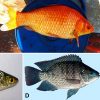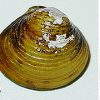calsfoundation@cals.org
Northern Snakehead
aka: Channa argus
aka: Snakehead
The northern snakehead (Channa argus) is a modern bony fish belonging to the family Channidae. It is native to China, eastern Russia, and parts of the Korean peninsula. The fish was discovered in Arkansas in 2008, leading to attempts to eradicate it.
The northern snakehead has an elongate body, with long dorsal and anal fins, and a truncated tail. Coloration is dark tan to brown with darker spots laterally, extending above and below the midline. The jaws have sharp, pointed teeth. The fish can reach a size of one meter and weigh as much as eight kilograms. The northern snakehead breathes with gills but also possesses a suprabranchial organ, which consists of chambers filled with folded tissue that allow atmospheric oxygen to be absorbed directly into the blood. A northern snakehead can survive out of water for several days, provided it remains moist. Rumors that northern snakehead walk on land are incorrect. Since none of the fins have spines, the ambulatory ability of a northern snakehead is limited to wriggling short distances.
The northern snakehead can live in water ranging from 0 to 30°C (32 to 86°F), inhabiting slow-moving tributaries of larger rivers or stagnant swampy areas with muddy bottoms and abundant vegetation. It consumes fish, invertebrates, and amphibians. The northern snakehead reproduces during spring and summer. Eggs are laid on top of a nest of floating vegetation and guarded by both parents. Young remain in schools, guarded by one or both parents. Females can spawn up to five times a year. Repeat spawning, parental care, and the ability to breathe air contribute to successful establishment of populations when the northern snakehead is introduced outside its native range.
Concern regarding the introduction of the northern snakehead is due to their position as a top predator. Few species are likely to prey on adult northern snakeheads in the United States. Northern snakeheads are likely to compete with other top predators. In systems with simple food webs, the northern snakehead could alter fish communities and decrease biodiversity.
A northern snakehead was discovered in a small pond in Maryland in 2002. Attempts to eradicate the species were unsuccessful. They have been taken from natural waters in California, Florida, Illinois, Massachusetts, New Hampshire, New York, North Carolina, Pennsylvania, Virginia, and Missouri. In April 2008, northern snakeheads were discovered in Arkansas in Big Piney Creek near Brinkley (Monroe County). The source of the introduction is uncertain. The fish might have been released by individuals who acquired them through the aquarium trade, or from a fish farm which legally acquired the fish prior to state and federal bans on snakehead importation and trade.
Concern that the northern snakehead would spread to the White, Arkansas, and Mississippi rivers led to a joint eradication effort between the U.S. Fish and Wildlife Service and the Arkansas Game and Fish Commission. Rotenone, a fish poison, was spread through more than 400 miles of ditches and creeks, killing thousands of the fish in March 2009.
For additional information:
Courtenay, W. R., Jr., and J. D. Williams. Snakeheads (Pisces, Channidae)—A Biological Synopsis and Risk Assessment. Circular 1251. Washington DC: U.S. Department of the Interior, U.S. Geological Survey, 2004.
Eifling, Sam. “Snakeheads: The Asian Fish that Terrified Arkansas.” Pacific Standard, June 14, 2017. Online at https://psmag.com/environment/snakeheads-16876 (accessed February 14, 2022).
Mather, Victor. “If you See This Creepy Fish, Cut Its Head Off.” New York Times, April 10, 2025. https://www.nytimes.com/2025/04/10/us/snakehead-fish-missouri.html (accessed April 10, 2025).
Novikov, N. P., A. S. Sokolovsky, T. G. Sokolovskaya, and Y. M. Yakovlev. The Fishes of Primorye. Vladivostok, Russia: Far Eastern State Technical University of Fisheries, 2002.
Okada, Y. “Studies of the Freshwater Fishes of Japan.” Journal of the Faculty of Fisheries Prefectural University of Mie 4 (1960): 1–860.
Steve Lochmann
Aquaculture/Fisheries Center
University of Arkansas at Pine Bluff








Comments
No comments on this entry yet.